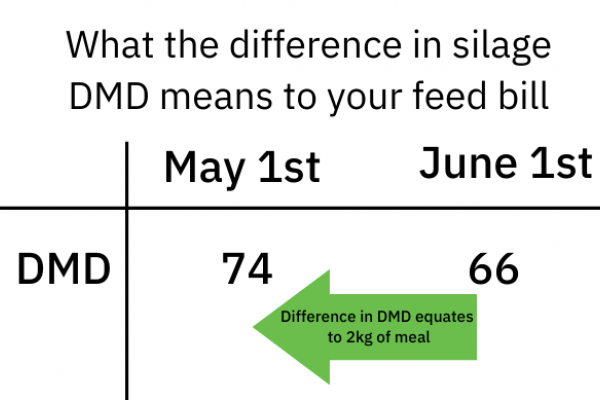Specialist Nutrition IE
Ballymountain, Waterford, X91 V6YR, Ireland
Specialist Nutrition IE
Ballymountain, Waterford, X91 V6YR, Ireland
Specialist Nutrition IE
Ballymountain, Waterford, X91 V6YR, Ireland

The national average for silage quality in Ireland has hovered in the mid-60 DMD range for the last number of years despite massive progression in technology, knowledge, and information available to farmers.
But silage quality can be improved by managing the controllables to minimise the impact of things, like weather, that are outside our control. We have seen that by taking this approach, farmers are regularly achieving DMD figures in the mid to high -70s with corresponding excellent protein, sugar & fibre levels.
Farmers should aim for first cut silage with as high as possible quality with crops not exceeding 10 tonnes per acre and utilise later cuts to build tonnage on the farm. Cutting a bulky, high tonne/lower quality first cut is a false economy – the cost of ensiling is the same whether good quality or bad!
An integrated approach maximises the quality of your grass silage and overall grass production on farm.
While we can never control the weather and growth conditions, there are some key areas we can focus on to produce better quality grass silage which can increase production from forage and reduce winter feed costs:
Less is more regardless of where the price is!
60-70 units of N plus 2500-3000 gallons of slurry is right for most farm situations. Heavier fertiliser applications will not counteract subpar growth conditions, so leave it in the bag!
Growth conditions vary year to year, and that, coupled with very changeable weather patterns can see grass mature differently each year.
- Evaluate the silage platform in late April to see how fertiliser uptake and grass maturation are progressing
- Watch the grass rather than the calendar so that if an early than expected weather window for harvesting appears you can make an informed decision
- In a year with weather such as what we are currently experiencing, it may be prudent to pre-cut test early to get an idea of what rate N is being taken up by the plants
2021 really showed the importance of cutting date in Ireland.

In the early days of May ’21 there was a short weather window in which to get grass silage done but very few took advantage of it. The weather broke and remained broken for nearly four weeks resulting in bulky, difficult to ensile, low quality, low protein crops being harvested.
While proteins generally remained lower than expected even in early cut grass silage, the stark difference in quality is shown here.

The impact of this is the extra cost needed to balance this forage in diets.
With 5 points DMD being equivalent to circa 1kg of meal, the 2021 figures above show that the later cut silage would require supplementation with over 2kgs of meal to match the feed value of the early cut silage. With concentrate feed costs reaching record highs in 2022 retaining that quality in your grass silage is more valuable than ever before.
- Pre-cut test your grass in plenty of time before your proposed cutting date to establish fibre/nitrate/sugar levels.
- Talk to your contractor well in advance of your proposed cutting date – there’s no point ringing the day the weather comes and being bottom of the list.
- Keep an eye on the weather and have your slab prepared and ready when the opportunity comes.
When it comes to first cut grass silage, it can never be too high in quality. It is the foundation of your winter nutrition, and the quality plays a huge role in determining the costs of your winter diets.
But in addition, your first cut silage sets the trajectory of the quality of your later grass silage cuts. A heavy first cut that strips the grass will result in lower quality second & third cuts no matter what you do. A higher quality, lighter tonnage first cut will see quicker regrowth and recovery leading to good later cuts. This is also important if the silage platform becomes part of the grazing rotation later in the year and you really want to maximise the grass production on your acreage.
As moist feed and forage specialists, Specialist Nutrition aims to help farmers improve farm returns by optimising the yield and quality of the forage they produce.
Taking a structured approach to your forage plan will help budget for the feed demands for the year ahead and navigate the key forage decisions to be considered in the months ahead.
Spring is the time to begin planning for the year ahead. The seeds you sow, whether grass, herbal ley, or beet or maize over the months of spring, can influence the performance of your herd and affect your forage budget this winter.
